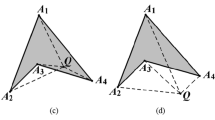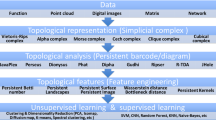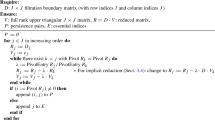Abstract
This paper describes an efficient shape representation framework for planar shapes using Voronoi skeletons.
This paper makes the following significant contributions. First a new algorithm for the construction of the Voronoi diagram of a polygon with holes is described. The main features of this algorithm are its robustness in handling the standard degenerate cases (colinearity of more than two points; co-circularity of more than three points), and its ease of implementation. It also features a robust numerical scheme to compute non-linear parabolic edges that avoids having to solve equations of degree greater than two. The algorithm has been fully implemented and tested in a variety of test inputs.
Second, the Voronoi diagram of a polygon is used to derive accurate and robust skeletons for planar shapes. The shape representation scheme using Voronoi skeletons possesses the important properties of connectivity as well as Euclidean metrics. Redundant skeletal edges are deleted in a pruning step which guarantees that connectivity of the skeleton will be preserved. The resultant representation is stable with respect to being invariant to perturbations along the boundary of the shape. A number of examples of shapes with and without holes are presented to demonstrate the features of this approach.
Similar content being viewed by others
References
C. Arcelli and G.S. Baja, “On the sequential approach to medial line transformation”, IEEE Trans. Syst. Man. Cybern., Vol. 8, No. 2, pp. 139–144, 1978.
C. Arcelli and G.S. Baja, “A width-independent fast thinning algorithm”, IEEE Trans, Patt. Anal. Mach. Intell., Vol. 7, pp. 463–474, 1985.
F. Aurenhammer, “Voronoi diagrams—A survey of a fundamental geometric data structure”, ACM Computing Surveys, Vol. 23, pp. 345–405, 1991.
H. Blum, “A transformation for extracting new descriptors of shape”, Models for the Perception of Speech and Visual Form, W. Wathen-Dunn (Ed.), MIT Press: Cambridge, MA, 1967.
H. Blum and R.S. Nagel, “Shape description using weighted symmetric axis features”, Pattern Recognition, Vol. 10, pp. 167–180, 1978.
G. Borgefors and G.S. Baja, “Skeletonizing the distance transform on the hexagonal grid”, Proc. Ninth Int. Conf. Patt. Recogn, Rome, Italy 1988, vol. 1, pp. 504–507.
M. Brady and H. Asada, “Smoothed local symmetries and their implementation”, International Journal of Roboties Research, Vol. 3, No. 3, pp. 36–61, 1984.
J.W. Brandt and V. Ralph Algazi, “Continuous skeleton computation by Voronoi diagram”, Computer Vision, Graphics and Image Processing: Image Understanding, Vol. 55, No. 3, pp. 329–338, 1992.
R.A. Brooks, “Symbolie reasoning among 3-D medels and 2-D images” Artificial Intelligence, Vol. 17, pp. 285–348, 1981.
P.E. Danielsson, “Euclidean distance mapping”, Comput, Graphics Image Processing, Vol. 14, pp. 227–248, 1980.
E.R. Davies and A.P.N. Plummer, “Thinning algorithms: A critique and a new methodology”, Pattern Recognition, Vol. 14, pp. 53–63, 1981.
A.R. Dill, M.D. Levine, and P.B. Noble, “Multiple resolution skeletons”, IEEE Trans. Patt. Anal. Machine Intell., Vol. PAMI 9, No. 4, pp. 495–504, 1987.
L. Dorst, “Pseudo-Euclidean skeletons”, in Proc. Eighth Int. Conf. Patt. Recogn., Paris, France, 1986, pp. 286–288.
S. Fortune, “A sweepline algorithm for Voronoi diagrams”, Algorithmica, Vol. 2, pp. 153–174, 1987.
R.C. Gonzalez and R.E. Woods, Digital Image Processing, Addison-Wesley, 1992.
C.J. Hilditch, “Linear skeletons from square cupboards”, Machine Intell., Vol. 4, pp. 403–420, 1969.
D.G. Kirkpatrick, “Efficient computations of continuous skeletons”, IEEE 20th Annual Symposium on Foundations of Computer Science, pp. 18–27, 1979.
L. Lam, S.W. Lee, and C.Y. Suen, “Structural classification and relaxation matching of totally unconstriined handwritten zipcode numbers”, Pattern Recognition, Vol. 21, No. 1, pp. 19–31, 1988.
L. Lam, S.W. Lee, and C.Y. Suen, “Thinning methodologies—A comprehensive survey”, IEEE Trans. Patt. Anal. Mach. Intell., Vol. 14, No. 9, p. 885, 1992.
D.T. Lee, “Medial axis transformation of a planar shape”, IEEE Trans. Patt. Anal. Machine Intell., Vol. PAMI 4, No. 4, pp. 363–369, 1982.
D.T. Lee and R.L. Drysdale, “Goneralization of Voronoi diagrams in the plane”, SIAM J. Computing, Vol. 10, No. 1, pp. 73–87, 1981.
F. Leymarie and M.D. Levine, “Simulating the grass-fire transform using an active contour model”, IEEE Trans. Patt. Anal. Machine Intell., Vol. PAMI 14. No. 1, pp. 56–75, 1992.
F. Leymarie and M.D. Levine, “Fast raster scan distance propagation on the discrete rectangular lattice”, Computer Vision, Graphic and Image Processing: Image Understanding, Vol. 55, pp. 84–94, 1992.
M. Leyton, “Symmetry-curvature duality”, Computer Vision, Graphics, and Image Processing, Vol. 38, pp. 327–341, 1987.
D.C. Marr and E. Hildreth, “Theory of edge detection”, in Proc. Royal Soc. London, Vol. B207, pp. 187–217, 1980.
N. Mayya, “Handprinted character recognition by Voronoi skeletons”, Ph.D. Dissertation, University of Florida, 1994.
S.N. Meshkat and C.M. Sakkas, “Voronoi diagram for multiply connected polygonal domains II: Implementation and application”, IBM J. Res. Develop., Vol. 31, No. 3, pp. 373–381, 1987.
F. Meyer, “Digital euclidean skeletons”, in Proceedings of the SPIE Conference on Visual Communications and Image Processing 90, Lausanne, Switzerland, 1990, Vol. 1360, pp. 251–262.
U. Montanari, “A method for obtaining skeletons using a quasi-Euclidean distance”, J. Assoc. Comput. Machinery, Vol. 15, pp. 60–624, 1968.
U. Montanari, “Continuous skeletons from digitized images”, JACM, Vol. 16, No. 4, pp. 534–549, 1969.
R. Ogniewicz, “Skeleton-space: A multiscale shape description combining region and boundary information”, Proc. Conf. on Computer Vision and Pattern Recognition, Seattle, Washington, 1994, pp. 746–751.
R. Ogniewicz and M. Ilg, “Skeletons with euclidean metric and correct topology and their application in object recognition and document analysis”, Proceedings of the 4th International Symposium on Spatial Data Handling, Zurich, Switzerland, 1990, Vol. 1, pp. 15–24.
R. Ogniewicz and M. Ilg, “Voronoi skeletons: Theory and applications”, Proc. CVPR, pp. 63–69, 1992.
T. Pavlidis, “An asynchronous thinning algorithm”, Computer Vision, Graphics and Image Processing, Vol. 20, pp. 133–157, 1982.
T. Pavlidis, Algorithms for Graphics & Image Processing, Computer Science Press, 1982.
S.M. Pizer, W.R. Oliver, and S.H. Bloomberg, “Hierarchical shape description via the multiresolution symmetric axis transform”, IEEE Trans. Patt. Anal. Mach. Intell., Vol. 9, No. 4, pp. 505–511, 1987.
H. Rom and G. Medioni, “Hierarchical decomposition and axial shape description”, IEEE Patt. Anal. Mach. Intell., Vol. 15, No. 10, pp. 973–981, 1993.
V. Srinivasan and L.R. Nackman, “Voronoi diagram for multiply connected polygonal domains I: Algorithm”, IBM J. Res. Develop., Vol. 31, No. 3, pp. 361–372, 1987.
V. Srinivasan, L.R. Nackman, J. Tang, and S.N. Meshkat, “Automatic mesh generation using the symmetric axis transformation of polygonal domains”, in Proceedings of the IEEE, Vol. 80, No. 9, pp. 1485–1501, 1992.
H. Talbot and L. Vincent, “Euclidean skeletons and conditional bisectors”, Proceedings of the SPIE Conference on Visual Communications and Image Processing 1992, Boston, MA, USA, 1992, Vol. SPIE-1818.
C.K. Yap, “An O (n log n) algorithm for the Voronoi diagram of a set of simple curve segments”, NYU-Courant Robotics Report No. 43, 1984.
Author information
Authors and Affiliations
Corresponding author
Rights and permissions
About this article
Cite this article
Mayya, N., Rajan, V.T. Voronoi diagrams of polygons: A framework for shape representation. J Math Imaging Vis 6, 355–378 (1996). https://doi.org/10.1007/BF00123352
Issue Date:
DOI: https://doi.org/10.1007/BF00123352




